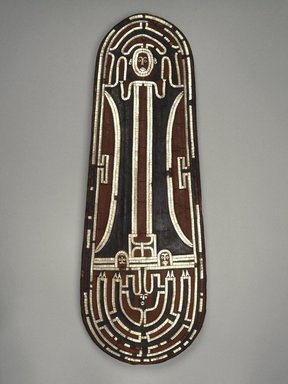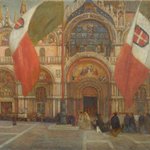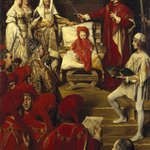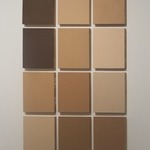

Guadalcanal Islander. Ceremonial Shield, before 1852. Basketry, nautilus shell, parinarium nut paste, pigment, 31 3/4 x 11 3/4 x 2 1/2 in. (80.6 x 29.8 x 6.4 cm). Brooklyn Museum, Frank L. Babbott Fund and Carll H. de Silver Fund, 59.63. Creative Commons-BY (Photo: Brooklyn Museum, 59.63_acetate_bw.jpg)
Ceremonial Shield
Arts of the Pacific Islands
The unparalleled virtuosity of the Solomon Islanders in the art of shell inlay is clearly demonstrated by this rare and richly embellished war shield, collected before 1852 by Surgeon Captain James Booth of the British Royal Navy. Only about twenty of these shields are extant today, and all are believed to have been made before 1840. Shell-inlaid shields were based on the more common elliptical wicker shields made on Guadalcanal and traded to Santa Isabel Islanders, who decorated the shield by covering it with red and black resins and setting in abstract linear designs created with small pieces of nautilus shell. Two detached heads and a face below, as well as a set of four double arrow-like points, distinguish this shield, whose characteristic design format is dominated by an anthropomorphic figure with upraised arms. These shields were too fragile for use and were designed as prestige items.
CULTURE
Guadalcanal Islander
MEDIUM
Basketry, nautilus shell, parinarium nut paste, pigment
GEOGRAPHICAL LOCATIONS
- Place collected: Santa Isabel Island, Isabel Province, Solomon Islands
- Place made: Guadalcanal Island, Guadalcanal Province, Solomon Islands
DATES
before 1852
DIMENSIONS
31 3/4 x 11 3/4 x 2 1/2 in. (80.6 x 29.8 x 6.4 cm) (show scale)
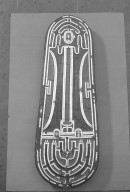


COLLECTIONS
Arts of the Pacific Islands
ACCESSION NUMBER
59.63
CREDIT LINE
Frank L. Babbott Fund and Carll H. de Silver Fund
CATALOGUE DESCRIPTION
Ceremonial shield, basketry base covered with red and black resin and inlaid with tiny mother-of-pearl squares in typical abstract human form design. Shield possibly used as currency.
Condition: fragile but good; - considering type of object. Few pearl shell inlaid missing, resin cracked.
MUSEUM LOCATION
This item is not on view
CAPTION
Guadalcanal Islander. Ceremonial Shield, before 1852. Basketry, nautilus shell, parinarium nut paste, pigment, 31 3/4 x 11 3/4 x 2 1/2 in. (80.6 x 29.8 x 6.4 cm). Brooklyn Museum, Frank L. Babbott Fund and Carll H. de Silver Fund, 59.63. Creative Commons-BY (Photo: Brooklyn Museum, 59.63_acetate_bw.jpg)
IMAGE
overall, 59.63_acetate_bw.jpg. Brooklyn Museum photograph, 2010
"CUR" at the beginning of an image file name means that the image was created by a curatorial staff member. These study images may be digital point-and-shoot photographs, when we don\'t yet have high-quality studio photography, or they may be scans of older negatives, slides, or photographic prints, providing historical documentation of the object.
RIGHTS STATEMENT
Creative Commons-BY
You may download and use Brooklyn Museum images of this three-dimensional work in accordance with a Creative Commons license. Fair use, as understood under the United States Copyright Act, may also apply.
Please include caption information from this page and credit the Brooklyn Museum. If you need a high resolution file, please fill out our online application form (charges apply).
For further information about copyright, we recommend resources at the United States Library of Congress, Cornell University, Copyright and Cultural Institutions: Guidelines for U.S. Libraries, Archives, and Museums, and Copyright Watch.
For more information about the Museum's rights project, including how rights types are assigned, please see our blog posts on copyright.
If you have any information regarding this work and rights to it, please contact copyright@brooklynmuseum.org.
RECORD COMPLETENESS
Not every record you will find here is complete. More information is available for some works than for others, and some entries have been updated more recently. Records are frequently reviewed and revised, and we welcome any additional information you might have.
